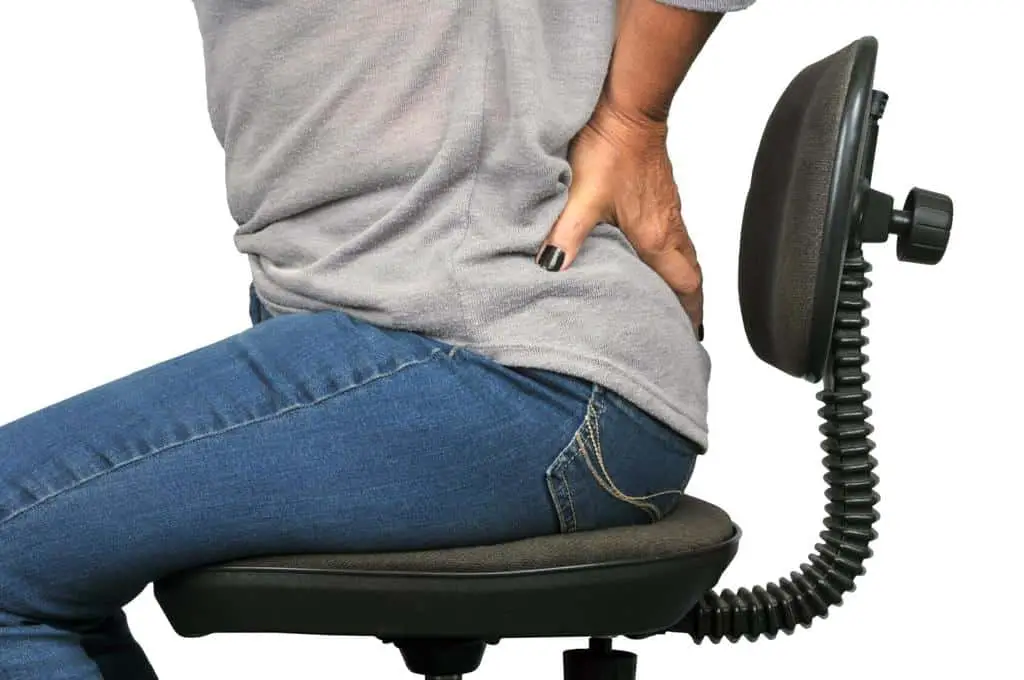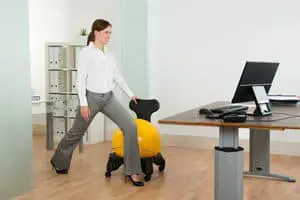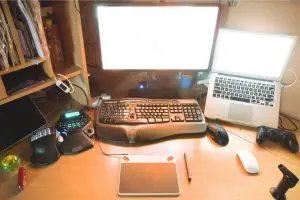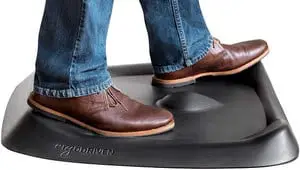Having to sit for a long period of time to do work becomes a big problem when you are experiencing sciatica. The fact that almost 41% of the average civilian spends the workday sitting doesn’t help your cause either. Sadly, we cannot deny that work is a big part of life.
When dealing with sciatica, the simplest tasks, like sitting, can feel like torture. It will not take long before the aches start knocking at the door. Because of this, it’s essential to understand the best way to sit with sciatica to help you get through the day pain-free.
All content and media on Office Solution Pro are created and published online for informational purposes only. It is not intended as a substitute for professional medical advice and should not be relied on as health or personal advice. This post may contain affiliate links.
One thing to keep in mind, however, is that knowing how to sit comfortably with sciatica is not the primary objective. The tips we will share are to help you minimize the discomfort while you perform your daily routine, more importantly, when you are required to sit down.
With this caveat out of the way, let’s take a deep dive into dealing with sciatica and how you can treat it through simple habit changes, both at home and at the office.
But before we do so, it’s important to learn how to recognize sciatica while taking a closer look at the way you sit. Chances are, your sitting posture is the underlying cause of this problem.
What is Sciatica?
According to the Cleveland Clinic, sciatica is a symptom, not a medical condition. This means that many diagnoses can manifest into sciatica. The main cause of the pain is caused by the pinching of one or more of the lower sciatic nerves.
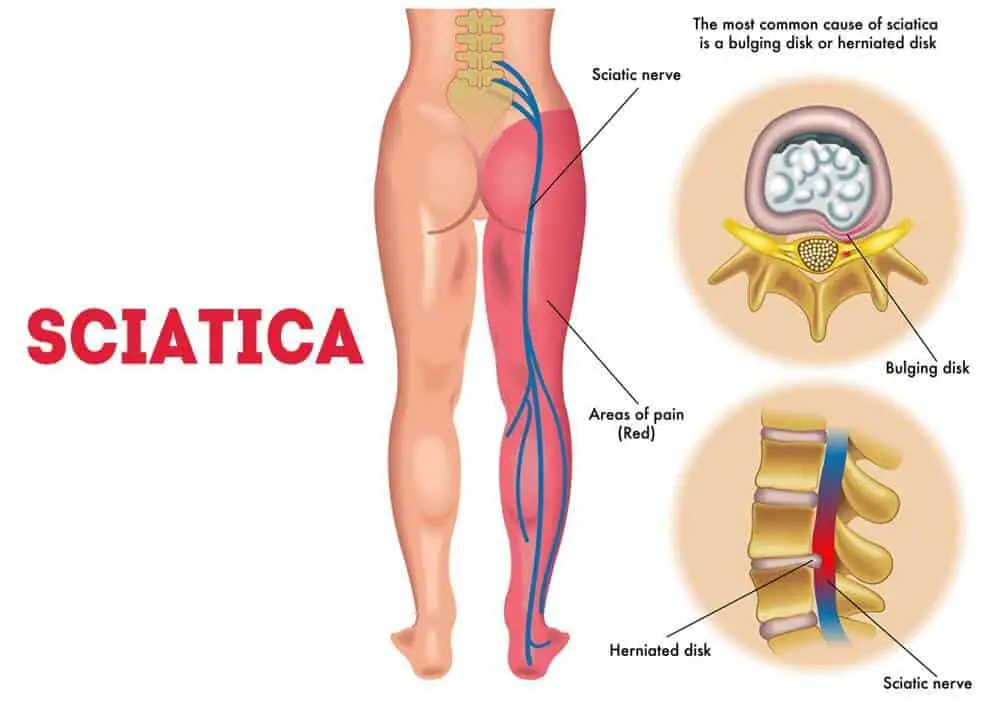
Image sourced from medium.com
Because it is the longest nerve in the human body, running across the lower spine down to the legs, they are prone to become irritated by many moving parts along the back and pelvis area.
Based on the information provided by the Mayo Clinic, the pain caused by sciatica can vary widely, from mild aches to excruciating pain. It can sometimes feel like an electric shock. Most of the time, only one side of the body is affected by sciatica.
What Causes Sciatica?
According to the Cleveland Clinic, sciatica can happen due to a number of different reasons. Conditions that may cause sciatica include:
- Herniated Disc – the most common cause of sciatica (90% – MedicalNewsToday)
- Piriformis Syndrome – happens when the piriformis muscle pinches the sciatic nerve
- Spinal Stenosis – narrowing of the spinal cord in the lower back
- Spondylolisthesis – a condition where a disk slips forward over the vertebra below it
- Tumors within the Spine – these may compress the root of the sciatic nerve
In many cases of sciatica, there is no single apparent cause. Your best bet for treating the symptoms is to consult your doctor or physician to help diagnose proper treatment. Imaging tests such as X-rays or MRIs may be necessary to help identify what is compressing the sciatic nerve and causing the symptoms.
On a side note, if you have been diagnosed with piriformis syndrome or you have a friend that is dealing with the symptoms, feel free to read our guide on how to sit properly right here.
Best Way to Sit with Sciatica
To help reduce some of the pain, it’s essential to understand the best sitting position for sciatica, especially when working a desk job. Some positions may help prolong your lower back and help you get relief from the constant aches.
1. Understand Proper Sitting Posture
Sitting in certain positions can trigger sciatica, especially when your body is not balanced. Most of the time, the biggest culprit is improper posture. Understanding proper sitting posture is key to achieving comfort while sitting with sciatica.
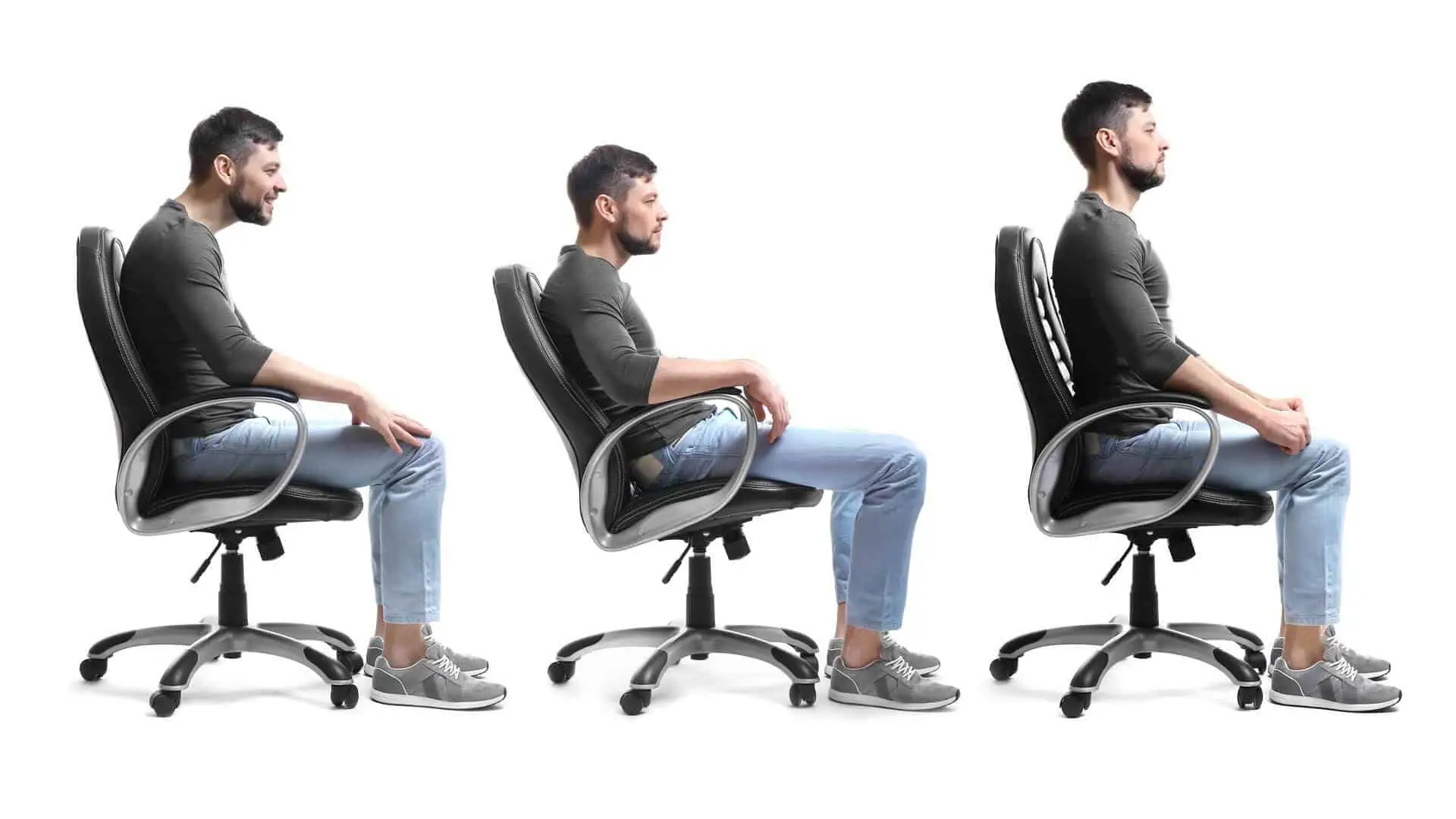
The best ergonomic office chair can help you to sit with proper posture, removing pressure from your lumbar spine.
These are the best practices for sitting to help reduce sciatic nerve pain:
- Sit up straight with your back and buttocks touching the back of your chair. Having your back properly supported is better than leaning forward.
- Sit with both feet on the ground. Having your legs hover off the floor for a long period of time can put tremendous strain on your lower body.
- Pivot your chair. If you need to turn around, use your office chair to rotate the chair together with your body rather than twisting your spine.
- Don’t cross your legs. Crossing your legs constricts healthy blood circulation in your lower body and may cause further numbness.
2. Support Your Lower Body
Now that we’ve covered the proper sitting posture, the next thing is to support your lower body. As humans tend to slouch, the best way to combat this is to properly support your lumbar spine and hips.
The first thing you would want to do is not to sit in a regular chair. While most office furniture is beautiful by design, they do little to support your lower body. Consider investing in the proper ergonomic office chair to support you best while sitting.
Not only does it help you maintain proper posture, but some are also equipped with recliners to help you relax your back every once in a while. The pivot function will help you rotate and move around with ease, avoiding stress on your lower back.
But if you are not in the position to replace your office chair, another viable option is to get yourself a sciatica seat cushion. These pillows are designed for tailbone pain relief, allowing you to reduce some of the pain in your buttocks while maintaining proper posture while sitting down.
3. Keep Everything Close
When dealing with sciatica, it’s best to avoid unnecessary movement when sitting at work. Keep everything in your workstation nearby to help you easily reach for anything. Not only is this more efficient, but it will help you relax and be at ease.
The best thing to keep in mind when creating a practical computer workstation is to position your monitor at eye level while keeping both your keyboards and your mouse within arm’s reach. If you use a phone constantly, keep it nearby to avoid reaching forward needlessly.
4. Apply Low, Continuous Heat
Applying heat to the area of pain is often overlooked when dealing with sciatica. Low and continuous heat can help promote healthy blood flow in the lower body. The best thing about this method is that you can use it to conveniently treat your sciatica flare-up anywhere, whether at home or at work.
Aside from heating pads, Topical creams or heat patches can provide fast and effective pain relief. Because these medications work by penetrating into your tissues while acting locally, they have a low chance of causing side effects. Just be sure to follow the directions on the package. Your commute may be a great place to get some back relief if you have heated seats.
5. Stretch Frequently
According to the Journal of Physical Therapy Science, certain mobilization techniques for the sciatic nerves may promote the healing of the soft tissues by stimulating the functions of the nervous system. Doing these stretches and exercises can help alleviate symptoms and decrease pain sensitivity.
These are the three best exercises for sciatica and sciatic nerve pain, according to Dr. Jose Guevara:
It’s best to be consistent and do these exercises daily. If you work at the office, these exercises can be done a few times during the day. Not only is this effective in combating the adverse effects of sciatica, but it’s a good reminder to remain active throughout the day.
Simple Tips to Prevent Sciatica
Becoming active is paramount to preventing sciatica and other lower-body injuries. Be sure to incorporate these simple tips to overcome the negative effects of a sedentary lifestyle:
- Park farther to get extra walking steps
- Use the stairs instead of an elevator
- Remember to walk and stretch every 20 minutes of sitting down
- Stay hydrated
- Perform simple stretches daily
Related Questions to Sciatica
1. Is sitting bad for Sciatica?
Sitting for long periods of time is bad for you. Period. Not only is it bad for your spine and sciatic nerve, but sitting is also linked to a number of health concerns, including increased blood pressure, high blood sugar levels, and excess body fat.
According to Mayo Clinic, an analysis of 13 studies has found that those who sat for more than eight hours a day, with little to no physical activity, had similar risks of dying from smoking and obesity.
No wonder that sitting has been named the new smoking. The bottom line is that sitting causes you to use less energy than you do when you stand or move, resulting in weaker muscles in the lower body and making you prone to injuries.
2. What kind of chair is best for Sciatica?
The best kind of chair for sciatica must have the proper back support. The best chairs with lumbar support reduce the load on your lower spine and can help alleviate sciatica symptoms. Not only do they help decompress nerve tension, but they provide ample padding to support your lower back.
We have dedicated a top 5 list of the best office chairs for sciatica. All of the chairs on the list are carefully selected by our team to ensure proper back and lower body support while sitting at work. Additionally, you’ll find an easy-to-follow buyers’ guide to help you make the best buying decision possible.
3. Does walking help Sciatica?
Walking can alleviate sciatic pain by reducing inflammation and promoting healthy blood flow. In addition to sciatica mobilization techniques, walking is a great way to relieve aches by releasing pain-fighting endorphins in the body.
An important thing to keep in mind, however, is to take shorter strides. Taking longer strides may cause overexertion and pinch the sciatic nerve, causing you to aggravate the symptoms. Take the time to understand the proper walking form to minimize the risk of injury.
Bottom Line
While the best way to sit with sciatica is only to help you cope with the pain, the best thing you can do to treat sciatica is to consult your doctor or physician to get the proper diagnosis. The sooner you get it checked, to better your chances are of eliminating the pain once and for all.
It’s never easy to go through daily activities while enduring sciatica. By taking the time to learn how to sit comfortably with sciatica, you are making sure that your body heals properly, all the while staying productive every day. 🙂
Citations
- Jeong UC, Kim CY, Park YH, Hwang-Bo G, Nam CW. The effects of self-mobilization techniques for the sciatic nerves on physical functions and health of low back pain patients with lower limb radiating pain. J Phys Ther Sci. 2016 Jan;28(1):46-50. doi: 10.1589/jpts.28.46. Epub 2016 Jan 30. PMID: 26957726; PMCID: PMC4755972.
